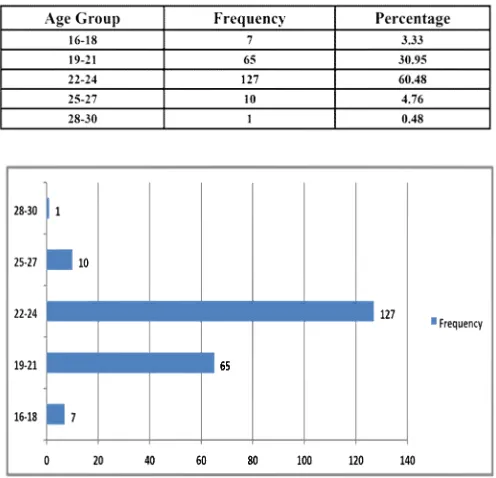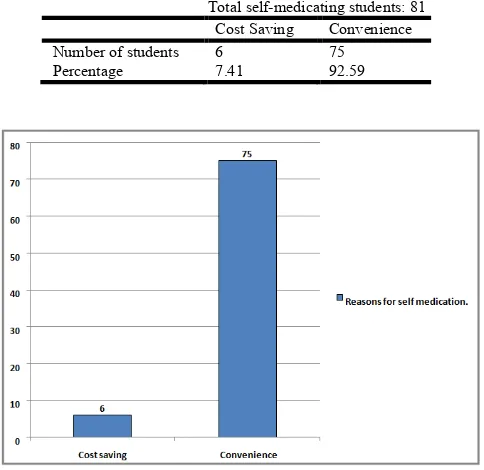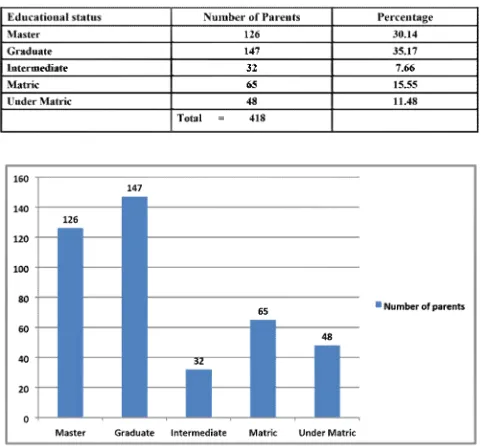THE GREAT THING IN THE WORLD IS NOT SO MUCH WHERE WE STAND, BUT
*
Dr. Marvi Malik, Dr. Wishah Urwatil Wusqa
Regarding Self Medication
ARTICLE INFO ABSTRACT
Background:
carried out but very few of them reflect the opinions of the medical students.
Objectives
among students of 4
Study Design: Setting:
completed and analyzed in the department of community medicine NMC, Multan, Pakistan.
Duration: Study Population: Inclusion Criteria: Exlusion Criteria: Sample Size: Results:
Copyright © 2018, Marvi Malik et al. This is an open access distribution, and reproduction in any medium, provided
INTRODUCTION
Self-medication refers to the selection and administration of medicine without the consultation of a doctor or a specialist and without the definitive diagnosis of the disease.
*Corresponding author: Dr. Marvi Malik,
Regarding Self Medication among 4th Year MBBS Students, of Nmc, Multan, Pakistan.
ISSN: 0975-833X
Vol.
Article History:
Received 30th October, 2017
Received in revised form 21st November, 2017
Accepted 19th December, 2017
Published online 31st January, 2018
Citation: Dr. Marvi Malik, Dr. Wishah Urwatil Wusqa, Dr. Maimoona Anwaar and Dr. Alishba Malik
much where we stand, but in what direction we are moving.
Key words:
Self medication, Students.
RESEARCH ARTICLE
THE GREAT THING IN THE WORLD IS NOT SO MUCH WHERE WE STAND, BUT
DIRECTION WE ARE MOVING
Dr. Marvi Malik, Dr. Wishah Urwatil Wusqa, Dr. Maimoona Anwaar and
Regarding Self Medication among 4
thYear MBBS Students, of Nmc, Multan, Pakistan
ABSTRACT
Background: A number of evaluations (at small and large scale) regarding selfmedication have been carried out but very few of them reflect the opinions of the medical students.
Objectives of the Study: To find out the knowledge, attitude and practices regarding selfmedication among students of 4th year MBBS NMC, Pakistan
Study Design: Cross-sectional observational study.
Setting: The study was carried out among 4thyear MBBS students of NMC, Multan and data was completed and analyzed in the department of community medicine NMC, Multan, Pakistan.
Duration: Study was conducted from 30th May, 2014 to 21st June, 2014.
Study Population: Students of 4th year MBBS NMC, Multan.
Inclusion Criteria: Students of 4th year MBBS.
Exlusion Criteria: Students of 1st, 2nd, 3rd, and final year MBBS are excluded from the study. Sample Size: Sample size was 210.
Results:
Age of 4thyear students ___3.33%(16-18 year), 30.95%(19 60.48%(22-24), 4.76%(25-27) & 0.48%(28-30)
Gender distribution of 4th year students__28.57% male students and 71.43% female students. Self-medication among 4th year students__ 45% male and 36% female students self
while 55% male and 64% female students do not self-medicate.
Educational status of Parents of 4th year students __30.14% are master, 35.17% are graduate, 7.66% are intermediate, 15.55% are matric and 11.48% are under matric.
Frequency of self-medication__ 12.34% students always, 66.67% off & on while 20.99% very rarely self-medicate.
Reasons for self-medication __ 92.59% students self-medicate for convenience while 7.41% for cost savings.
Common complaints for self-medication __ 40.15% complaints are of Headache, 36.50% are of fever while 23.35% are of common cold.
2
Commonly used drugs for self-medication __ 44.67% panadol, 19.38% dispirin, 12.92% ibuprofen, 12.08% metronidazole and 10.95% augmentin are used.
Adverse reaction by self-medication __ 93.83% students did not observe adverse reactions while 6.17% observed adverse reactions.
Conclusion: From the study we concluded that self-medication is commonly practiced in 4 year students of the institute. There is a dire need to create awareness and educate the students about the dangers of self medication.
access article distributed under the Creative Commons Attribution the original work is properly cited.
medication refers to the selection and administration of medicine without the consultation of a doctor or a specialist and without the definitive diagnosis of the disease.
Year MBBS Students, of Nmc,
It manifests as a major challenge in all classes of people whether literate or illiterate, wealthy or famished, rural or urban. While self-medication has the comfort and conveniance of liberating time money and energy, it is not proposed on account of hazards posed by multiple adverse effects that can result from improper self-diagnosis, wrong doses, incorrect timing & inappropriate choices of medicines, development of resistance and progression of disease du
International Journal of Current Research
Vol. 10, Issue, 01, pp.64642-64646, January, 2018
Dr. Marvi Malik, Dr. Wishah Urwatil Wusqa, Dr. Maimoona Anwaar and Dr. Alishba Malik, 2018. “
much where we stand, but in what direction we are moving.”, International Journal of Current Research, 10, (01), 64642
THE GREAT THING IN THE WORLD IS NOT SO MUCH WHERE WE STAND, BUT IN WHAT
Dr. Alishba Malik
f Nmc, Multan, Pakistan
A number of evaluations (at small and large scale) regarding selfmedication have been carried out but very few of them reflect the opinions of the medical students.
To find out the knowledge, attitude and practices regarding selfmedication
year MBBS students of NMC, Multan and data was completed and analyzed in the department of community medicine NMC, Multan, Pakistan.
June, 2014.
, and final year MBBS are excluded from the study.
18 year), 30.95%(19-21),
__28.57% male students and 71.43% female students. year students__ 45% male and 36% female students self-medicate
medicate.
year students __30.14% are master, 35.17% are graduate, atric and 11.48% are under matric.
medication__ 12.34% students always, 66.67% off & on while 20.99% very
medicate for convenience while 7.41%
medication __ 40.15% complaints are of Headache, 36.50% are
medication __ 44.67% panadol, 19.38% dispirin, 12.92% 0.95% augmentin are used.
medication __ 93.83% students did not observe adverse reactions
medication is commonly practiced in 4th udents of the institute. There is a dire need to create awareness and educate the students
License, which permits unrestricted use,
It manifests as a major challenge in all classes of people whether literate or illiterate, wealthy or famished, rural or medication has the comfort and conveniance and energy, it is not proposed on account of hazards posed by multiple adverse effects that can diagnosis, wrong doses, incorrect timing & inappropriate choices of medicines, development of resistance and progression of disease due to lack of appropriate
OF CURRENT RESEARCH
diagnosis and treatment. Students of medical field have been discerned to be particularly inclined towards it, utilizing their medical knowledge as a plus point and a confidence booster.
Objectives
To study knowledge, attitude and practices of 4th year MBBS students regarding self-medication.
To determine the frequency of self medication among students.
To ascertain the rationalization for self-medication.
To discover the prevailing complaints for self-medication among self-medicating students.
To find out the drugs commonly used for self-medication among self-medicating students.
To determine the percentage of adverse effects that were encountered as a result.
RESULTS
[image:2.595.312.554.52.237.2]Table 1. Age distribution of the students
Figure 1. Frequency distribution of students according to age groups
Total students: 210 Frequency distribution of age: Frequency
distribution of students according to their age group.
[image:2.595.41.289.311.550.2]Figure 1 Out of total, 3.33% (16-18 year), 30.95% (19-21), 60.48% (22-24), 4.76% (25-27) & 0.48% (28-30) Gender Distribution Of 4th Year MBBS Students.
Table 2. Gender Distribution of 4th Year MBBS Students
Gender Number of students Percentage
Male students 60 28.57
Female students 150 71.43
Figure 2. Gender Distribution of 4th Year MBBS Students
Out of total, 28.57% are male students and 71.43% are female students.
Table 3. Frequency distribution of Self-medication among male and female students of 4th Year MBBS
Total students: 210
Male students
Percentage Female
students
Percentage
Who self medicate 27 45 54 36
Who do not self medicate
33 55 96 64
Total 60 150
Figure 3. Frequency distribution of self-medicating and non-self-medicating male and female students
Out of total male students, 45% self-medicate and 55% do not medicatewhile among total female students, 36% self-medicate and 64% do notselfself-medicate.
Table 4. Frequency distribution of medication among self-medicating students
[image:2.595.307.560.340.572.2] [image:2.595.66.258.702.735.2]Figure 4. Frequency distribution of self-medication among the students
[image:3.595.38.289.53.234.2]Out of total self-medicating students, 12.34% students always, 66.67% off &on while 20.99% very rarely self-medicate
Table 5. Frequency Distribution of Reasons for Self-Medication Among Students Of 4th Year MBBS
Total self-medicating students: 81 Cost Saving Convenience
Number of students 6 75
Percentage 7.41 92.59
Figure 5. Distribution of reasons for self-Medication among the students
[image:3.595.312.554.268.516.2]Out of total medicating students, 92.59% students self-medicate forconvenience while 7.41% for cost savings.
Table 6. Frequency Distribution of common complaints for self-medication
Out total complaints, 40.15% complaints are of Headache, 36.50% are of fever while 23.35% are of common cold
Figure 6. Common complaints for self-medication
Table 7. Frequency Distribution of Commonly Used Drugs for Self Medication
DRUGS PERCENTAGE
Dispirin 19.38
Augmentin 10.95
Panadol 44.66
Metronidazole 12.08 Ibuprofen 12.92
Figure 7.Distribution of Commonly Used Drugs for Self Medication
Out of total commonly used drugs, 44.67% Panadol, 19.38% Dispirin, 12.92%Ibuprofen, 12.08% Metronidazole and 10.95% Augmentin are used.
Table 8. Frequency distribution of self-medicating students on the basis of encountering or not encountering the adverse reaction by
self-medication
[image:3.595.44.286.334.569.2] [image:3.595.308.553.655.705.2]Figure 8. Frequency distribution of self-medicating students on the basis of encountering or not encountering the adverse reaction
by self-medication
Table 9. Frequency distribution of educational status of the parens of students of 4th year MBBS
Note: Each father and each mother is treated as a single parent
Out of total parents, 30.14% are master, 35.17% are graduate, 7.66% are intermediate, 15.55% are matric and 11.48% are under matric
DISCUSSION
Our research was conducted to see the habit of self-medication among students of 4thyear MBBS NMC, Multan. The present study indicates that self-medication is routinely practiced (38.57%) among 4th year medical students of NMC. In our study it was found that practice of self-medication was more prevalent among males (45%) than females. (36%) Total 210 students were included in KAP study, out of which 71.43% were females and 28.57% were males. 60.48% of all of these students were of age 22-24 years, 30.95% were of age 19-21 years, 4.76% were of age 25-27 years, 3.33% were of age 1618 years while 0.48% were of 28-30 years. Most common complaints for which medical students undergo selfmedication include headache (40%), fever (37%) and common cold (23%). Our research illustrated that 12.3% of students always go for selfmedication when they become ill while 67% use it off and on and 21% rarely use it. The most prevalent reason for the selection of self-medication was convenience (93%). The
second reason was cost savings (7%). The most commonly used drugs were panadol (45%), dispirin (19.3%), ibuprofen (13%), metronidazole (12%) and augmentin (11%). 94% of all the students who self-medicate were not encountered any adverse reaction while 6% of these had adverse reactions.
LIMITATIONS
The study was hinged on supported data about self-medication in preceding 1 year, thus prone to recall bias.
Moreover, although the students were encouraged to complete the questionnaire independently, mutual influence between the students could not be entirely ruled out.
The conclusions drawn by the study would have been more generalized if it involved students of other classes or other medical colleges.
Conclusion
Our study is consistant with the fact that prevalence of self-medication is precariously high in medical students of fourth year MBBS although being in medical field they are expected to be acquinted with the matter at hand. Thus our study manifests that self-medication is frequently practiced in students of the institute with analgesics being most commonly used and headache and fever being predominating morbidities for seeking self-medication. In these circumstances, faculty of the institute should create awareness and educate their students regarding draw backs of self-medication. Our study also appreciates the need of multicentric studies involving wider sections of medical professionals to estimate the magnitude of self-medication practice in medical fraternity. We recommend a holistic approach to prevent this problem from escalating further. This is a real issue and not to be taken lightly.
Recommendation
Students should possess thorough knowledge and apprehension regarding the hazards of self-medication. This is necessary if we aim to put an end to the practice of self medication.
In case of an ailment, students should be encouraged to make an appointment with the doctor and not suggest medication based on their own interpretation.
Parents should also be addressed concerning the threats of self medication.
To extend the awareness regarding hazards of self medication to general public, health practitioners ought to utilize the platform of electronic and print media.
Medicine should not be given to the public without the prescription of a registered medical practitioner
Easy access to the health care facilities should be ensured bearing in mind the principles of equity, efficiency, affordability, acceptability and timing.
REFERENCES
[image:4.595.43.284.287.510.2]Gupta, Y.K. 2013. Popularity of self-medication among medical students, AIIMS. Available at www.INDI Aedunews.net. Accessed 19 January 2013.
Hem, E., Stroke, G., Tyssen, R., Gronvold, N.T., Vaglum, P., Ekeberg, O. 2005. Selfprescribing among young Norwegian doctors: a nine-year follow-up study of a nation wide sample. BMC Med; 3 : 16. [DOI via Crossref] [Pubmed] [PMC Free Fultext]
James, H., Handu, S.S., Khaja, K.K., Sequeira, R.P. 2008. Influence of medical training on self-medication by students. Int J Clin Pharmacol Ther., 46 ; 23-9. [Pumbed] Lam, C.L., Catarivas, M.G., Munro, C., Launder, I.J. 1994.
Self-medication among Hong Kong Chinese. SocSci Med.,
39 : 1641-7.[DOI via Crossoef]
Nalini, G.K. 2010. Self-medication among Allopathic medical Doctors in Karnataka, India. BJMP; 3 : 325.
Phalke, V.D., Phalke, D.B, Drugawale, P.M. 2006. Self-medication Practices in Rural Maharshtra. Indian J
Community Medicine 31 : 34-5. [DOI via Crossref]
Sanghani, S., Zaveri, H.G., Patel, V.J. 2008. Self-medication: Prevalence and Pattern in urban community. J
Pharmacovigilance Drug Saftey, 5: 95-8.
World Health Organization: Guidelines for the regulatory assessment of Medicinal Products for use in
self-medication. WHO/EDM/QSM/0.01,2000.
Zafar, S.N., Syed, R., Waqar, S., Zubairi, A.J., Vaqar, T., Saikh, M., Yousaf, W., Shahid, S., Saleem, S. 2008. Self-medication amongst university students of Karachi: Prevalence, Knowledge and Attitudes. J Pak Med Assoc; 58: 214-8. [Pubmed]


